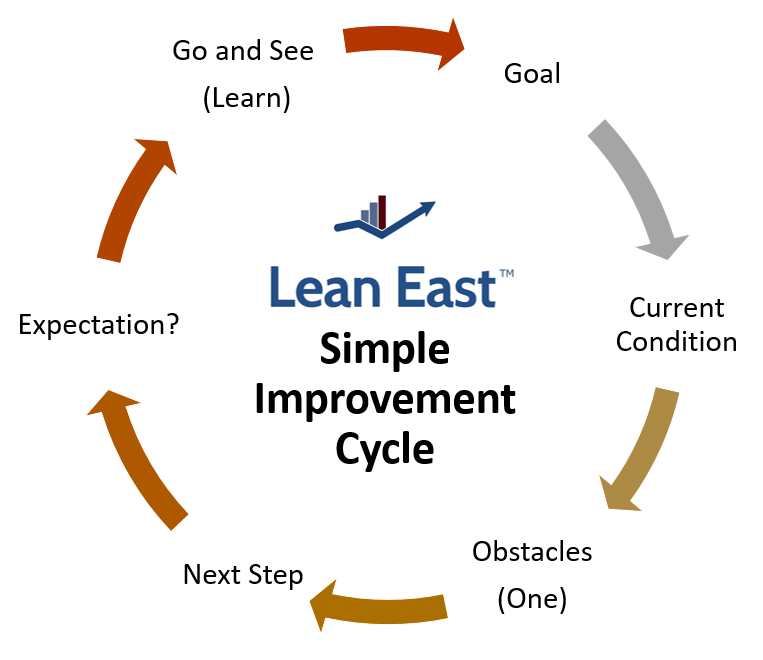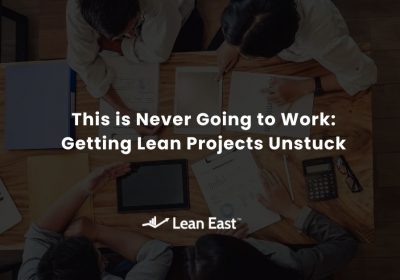Lean East shares our improvement cycle and the need to experiment to learn and grow.
We are pleased to offer this monthly lesson as a video post! You can read the lesson below, which is a formatted transcript of the presentation, or watch the 5-minute video embedded at the end.
Allowing For Trial & Error: A Better Way To Grow & Compete
Have you ever worked in a place where the goal is to be unnoticed and the boss visits your area only if you are about to hear bad news? I have seen too many organizations where employees just go through the motions, doing what they are told.
Raises and advancements at these workplaces are based primarily on not making mistakes. Employees are told what to do and managers make the decisions. There is no incentive to take on a challenge, learn new skills, or risk anything.
Experiment to Learn
Organizations that succeed today must learn and innovate faster than their competition. The key to this learning is experimentation practiced at every level of the organization.
This concept is based on three key ideas:
- The world is more complex and changing faster than at any time in history. The internet, open-sourced software, and social media allow your customers to quickly find and switch to better solutions.
- Knowledge as an individual and organization is not fixed. Our brains are like muscles, they will grow in strength when challenged, but we don’t learn without repeated practice and failure.
- Small, repeated improvements have much greater effects than occasional major projects. This is the compound effect – the same reason that if you start investing just a few dollars every day at age 20 you can retire a millionaire.
I’m going to share a simple, proven improvement cycle that you can use to position your organization to excel and grow. With this improvement cycle, you can experiment to grow!
Hospital Improvement Example
My team and I help leaders and organizations think of this cycle as a science experiment. Failure is encouraged, but only when there is learning. In a year-long hospital improvement project, one nurse I worked with had a recurring issue with transferring patients from registration to the operating room. I helped her design a simple experiment as a test of change.
We began by identifying the overall goal. The hospital team wanted to simplify and shorten the time it took for patients to be registered and admitted for their procedure.
Next, we identified the current condition. In this hospital, we had recently made several small process improvements that enabled data to transfer between departments quickly, but there was one remaining obstacle. Some patients were taking too long to find their way between registration and the OR waiting area. We decided to focus on improving this one obstacle as a next step.
The OR nurse had a hypothesis that if she met and escorted patients traveling between departments it would speed up the process. We decided to have her try escorting patients for a week to see how much it helped.
After running her test for just a few days, she found that her effort helped in some instances but many more times she was not available when registration called for an escort. Patients were now waiting too long for her to arrive to escort them!
The team decided that a good next experiment would be to see if the registration department staff could escort patients to the OR. Everything was set up to repeat the cycle and try a new experiment. The hospital ended up identifying a new, improved process which they implemented with success.
Lean East Improvement Cycle

Leaders and employees can experiment and learn just like this hospital team did. Remember to plan simple experiments that address one issue at a time. The goal here is to use the Improvement Cycle and experiment to grow!
Tips for Leaders
Some of you here are leaders. I have three tips for you as you help your employees experiment and learn:
- Set a good example, but avoid giving your employees the answers. It is your job to encourage and coach them so they can develop their thinking skills and become leaders themselves.
- Encourage experimentation and failure in the interest of learning.
- Remove barriers for your employees, especially when dealing with other company leaders who don’t embrace failure as you do.
Tips for “Future Leaders”
I have a few tips for employees and future leaders as well.
- Seek permission and buy-in from your leader before you experiment and fail. You may need to explain the improvement cycle and learning goals to them first.
- Be sure to focus on the facts and data.
- Always celebrate successes with your leader.
Experiment to Grow
Many top companies have grown by experimentation and I want you to do the same. Imagine what your culture will be if you adjust quickly after learning what customers value and develop good habits for both leaders and employees. You can continuously improve overall outcomes in your organization
Thank you – now go forth to learn and grow!
Portland, Maine DisruptHR
I took the core concepts from this post on the road in June for the international DisruptHR program. The event is like a TED Talk but uses the PechaKucha format of 5-minutes total requiring 20 slides that automatically advance every 15 seconds. I was one of several speakers for the Portland, Maine event and found the format harder to prepare for than expected.
Please take a moment to check out my talk. It was recorded live at the event and is a little rough at the start. Not being able to control the timing of the slides can be painful for a speaker and I panicked a bit at one point when my slide advanced early (actually, I forgot my line when I fell behind in my timing). I think I recovered though, and successfully shared my lesson with the audience.
I’d appreciate comments about your experience with presenting using this format, and any positive comments about the video and lesson are welcome too! We are all our own worst critics. Thanks – now click the video below to play!





NIce job, Steve. I hope you get the chance to do more work on this kind of stuff.